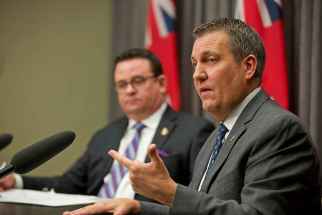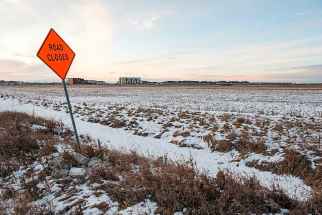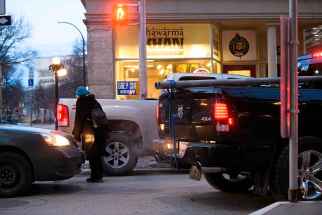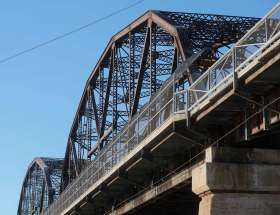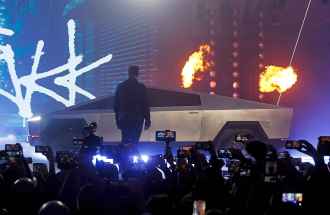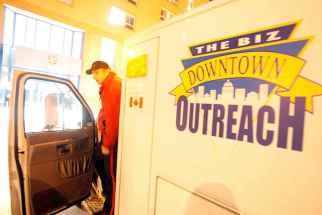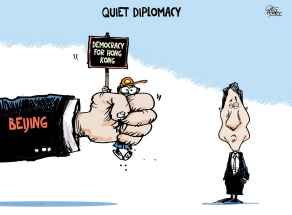City ranks top 45 infrastructure needs
Read this article for free:
or
Already have an account? Log in here »
To continue reading, please subscribe:
Monthly Digital Subscription
$0 for the first 4 weeks*
- Enjoy unlimited reading on winnipegfreepress.com
- Read the E-Edition, our digital replica newspaper
- Access News Break, our award-winning app
- Play interactive puzzles
*No charge for 4 weeks then price increases to the regular rate of $19.00 plus GST every four weeks. Offer available to new and qualified returning subscribers only. Cancel any time.
Monthly Digital Subscription
$4.75/week*
- Enjoy unlimited reading on winnipegfreepress.com
- Read the E-Edition, our digital replica newspaper
- Access News Break, our award-winning app
- Play interactive puzzles
*Billed as $19 plus GST every four weeks. Cancel any time.
To continue reading, please subscribe:
Add Free Press access to your Brandon Sun subscription for only an additional
$1 for the first 4 weeks*
*Your next subscription payment will increase by $1.00 and you will be charged $16.99 plus GST for four weeks. After four weeks, your payment will increase to $23.99 plus GST every four weeks.
Read unlimited articles for free today:
or
Already have an account? Log in here »
Hey there, time traveller!
This article was published 28/11/2019 (2203 days ago), so information in it may no longer be current.
While residents might prefer to see replacements for the Arlington or Louise bridges, city bureaucrats say Winnipeg’s top three pressing needs include upgrading a sewage plant, relocating the insect-control centre and replacing residents’ water meters.
That’s according to the city’s infrastructure plan, released Thursday, which could help inform how all three levels of governments prioritize spending on large projects in the city.
Infrastructure plan prioritized investment needs
City council tasked bureaucrats with ranking large projects and assets, resulting in a list of 45 investments. Here is the ranked list of 45 projects.
City council tasked bureaucrats with ranking large projects and assets, resulting in a list of 45 investments. See further details on the ranking and each project in the document at the bottom of this page, or in the PDF file online here.
- NEWPCC Upgrade: Biosolids
- Insect Control Buildings and Yards Replacement
- Water Meter Renewals
- NEWPCC Upgrade: Nutrient Removal
- Bus Radio Replacement
- Brady Road – Onsite Leachate Management
- North Transit Garage Replacement
- CIWMS – Source Separated Organics Composting Facility & Carts
- Southwest Interceptor (Wastewater)
- Airport Area West Water & Sewer Servicing
- Police Archival & Exhibit Building
- St. Vital Bridge Rehabilitation
- Electric Bus Pilot Project
- Route 90 Improvements – Taylor to Ness
- Pembina Highway Overpass (Bishop Grandin) Rehabilitation
- Windsor Park & Waverely West Fire Paramedic Stations
- Osborne Fire Paramedic Station
- Harbourview Complex (Kilcona Park Renewal)
- Lagimodiere Twin Overpasses Rehabilitation
- Silver Heights Fire Paramedic Station
- St. Mary’s Road Widening – St. Anne’s to Marion
- East of the Red Rec Plex
- South Winnipeg Recreation Campus
- Osborne Street Underpass
- Bishop Grandin Extension East – Lagimodiere to Fermor
- Louise Bridge Replacement
- Rapid Transit Future Corridors
- City Centre Fire Paramedic Station
- Chief Peguis Trail Extension West – Main to Brookside
- Southeast Winnipeg Recreation Facility
- Arlington Bridge Replacement
- Boni-Vital Pool
- St. James Civic Centre Expansion
- Southeast Winnipeg Library
- St. Boniface Fire Paramedic Station
- Tyndall Park Community Centre
- Police Indoor Firing Range
- Kildonan Fire Paramedic Station
- Fort Rouge – McFayden Active Transportation Crossing
- Edward Schreyer Pkwy – Plessis to Chief Peguis
- Fermor and Lagimodiere Interchange
- Fort Garry Fire Paramedic Station
- Police Rapid Response Training Facility
- Transit Customer Services/Admin Building
- Bishop Grandin Greenway pedestrian overpass
City council tasked bureaucrats with ranking large projects and assets, resulting in a list of 45 investments.
The civil servants ranked these based on points, in which legal obligations and maintaining current service each make up a third of the points; other priorities that are ranked secondary include improved service, job creation and environmental sustainability.
Projects like water, emergency services and regional roads were ranked highest, while golf courses, libraries and pet adoptions were near the bottom.
“The city must balance a multitude of competing spending priorities with limited resources,” reads the plan, which only applies to projects that cost more than $5 million. That criteria makes up about half the city’s capital needs.
That’s why the estimated $3.5-million fix to the crumbling passageways below Portage and Main didn’t make the list, as Thursday’s plan only assessed larger projects.

In its ranking, the $31-million Arlington St. bridge replacement sits as 31st most important for the city.
Meanwhile, a half-billion-dollar upgrade to the North End Sewage Treatment Plant is top priority, because the plant’s equipment is aging and can’t keep up with a growing population, nor regulations on biosolids.
Priority No. 4 is for nutrient removal at that plant.
The city’s second priority is relocating the Insect Control Building and its heliport from Elmwood to the south-end sewage plant because the aging building won’t be allowed to use helicopters when the rapid-transit route is in service.
‘Optimism’ for collaborating on infrastructure
All three levels of government are finally striking the same tone on infrastructure, as the Liberals push to actually get things built in their unstable minority mandate. Yet it remains unclear what types of projects Ottawa will prioritize.
OTTAWA — All three levels of government are finally striking the same tone on infrastructure, as the Liberals push to actually get things built in their unstable minority mandate. Yet it remains unclear what types of projects Ottawa will prioritize.
“There’s some optimism,” Coun. Jeff Browaty said. “I think there is a chance.”
He was speaking on the sidelines of this week’s Federation of Canadian Municipalities meeting in Ottawa, during which a hundred mayors and councillors heard from federal leaders.
“My first priority is getting things built quickly that matter in the lives of Canadians,” said Catherine McKenna, the Liberals’ newly minted infrastructure minister, who donned a hardhat.
The former environment minister told the FCM summit Wednesday that she aims to prioritize climate-resiliency projects that spur jobs.
Browaty said he hopes that money will help Winnipeg get electric buses, but he was left wondering whether McKenna is prioritizing faster or greener solutions.
“We’re spending a lot of money and a lot of time now figuring out what electric transit is going to look like, but if the priority of this government is to get stuff out quickly — electricity’s a little more involved,” he said, wondering if the government would prefer to roll out more gas-powered buses.
A major impediment to the Liberals’ infrastructure push has been belt-tightening provinces like Manitoba rebuffing demands to cost-share projects with Ottawa, including when cities like Winnipeg have put up their share.
This spring, the Liberals doubled the municipal revenue from a longstanding gas tax, in order to have some progress on road repairs to show voters.
On Thursday, the FCM released a roadmap for the Liberals’ first 100 days as a minority government, calling for funding major projects “more directly to municipalities” by 2021, through the gas tax.
“Long-term and predictable funding empowers local leaders to plan smart and save money,” the group argues.
The Liberals’ platform shied away from the FCM’s earlier suggestion of creating a permanent mechanism for Ottawa to interact with cities, which remain the legal responsibility of their provinces.
In this month’s Throne Speech, Manitoba’s Brian Pallister government said it wants to take on more infrastructure projects.
McKenna told reporters she’s “confident” she can find common ground with the provinces, but isn’t afraid to over their heads.
“Certainly we don’t want to be in that situation, but we have said [if] we can’t get things built, we have to have a tool to do that.”
The federal Liberals have earmarked a whopping $188-billion for infrastructure projects, but projects have been gummed up by construction delays and bureaucracy.
The parliamentary budget officer also found provinces rearranging their pots of funding in order to effectively absorb the money.
— Dylan Robertson
Priority No. 3 is to upgrade “outdated” water meters on city properties and homes, which it argues will help detect leaks.
While civil servants have tried to flag the projects that Winnipeggers actually need, politicians are constantly under pressure to fund things the public regularly interacts with.
A pilot project for buying and testing 12 to 20 electric buses comes in at $27 million, and is 13th on the priority list.
That’s far less pressing than the city’s fifth-place suggestion of replacing transit buses’ three-decades-old radio sets for $20 million.
Similarly, widening Route 90 to alleviate bottlenecks on Kenaston Boulevard is a half-billion door project that ranks as priority No. 14.
Introducing curbside compost bins to save on landfill fees would cost the city $101 million, which ranks as priority No. 8.
The last priority of all 45 is a walk/bike bridge over Pembina Highway.
Last year, the city pegged its infrastructure deficit for the looming decade as a $6.9 billion gap between the capital funding in place and what’s needed to maintain and build new roads, pools and wastewater-treatment plants.
dylan.robertson@freepress.mb.ca
City of Winnipeg 2020 Infrastructure Plan



